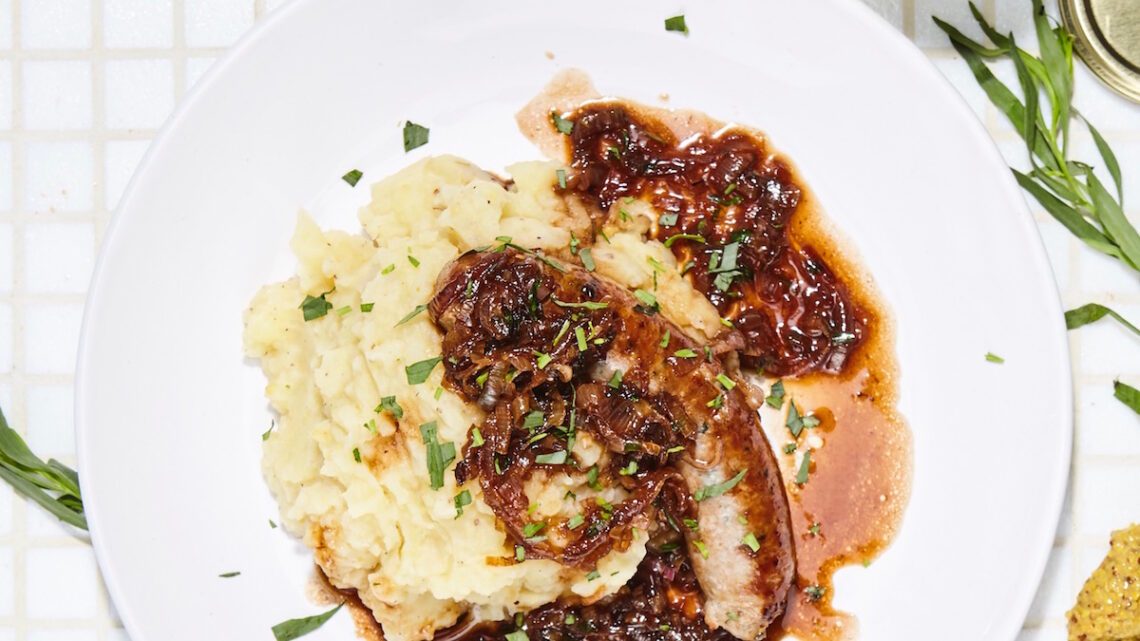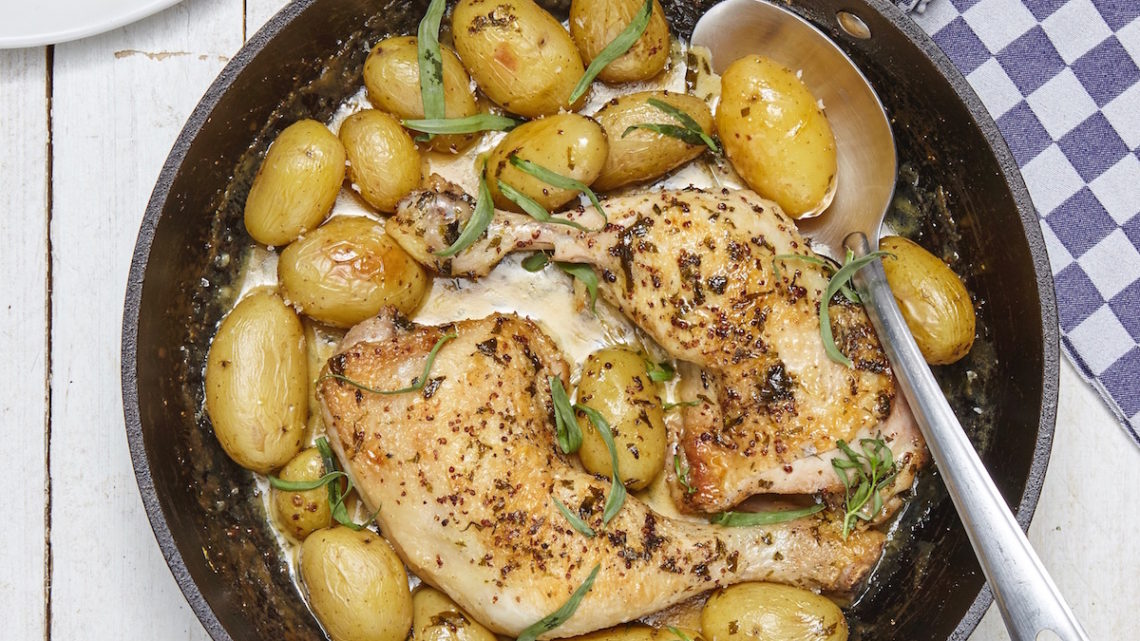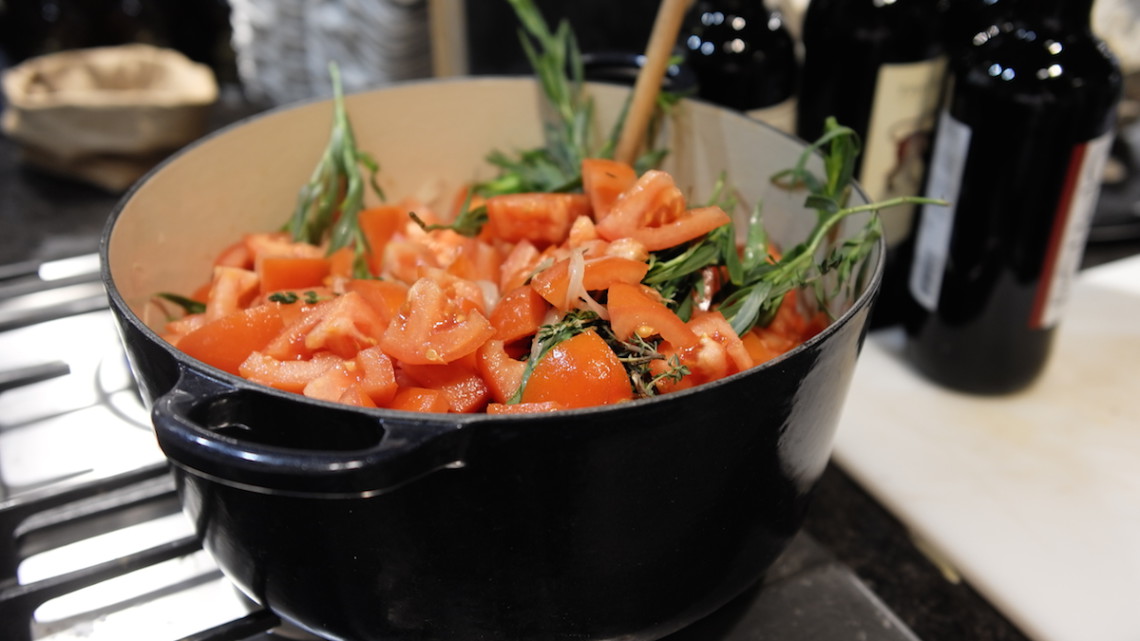Sausages with Pear-Potato Mash & Mustard
There's nothing more English than sausages and mash. It's the ultimate comfort food! Give it a Dutch twist by using good quality, locally reared pork sausages and local pears through the mash which work so well with pork.
serves 2
Ingredients
2 good-quality pork sausages of your choice, about 150g each
1 small bunch tarragon
2 pears
350g shallots
600g floury potatoes
35g butter
1 tablespoon brown sugar
2 tablespoon olive oil
50-100 ml milk
1 teaspoon wholegrain mustard
2 tablespoons red wine- or balsamic vinegar
salt and pepper
Method
Peel the potatoes in cut into 2 cm cubes. Peel the pears and cut into slices. Finely slice the shallots into rings.
Place the potatoes and pears in pan with cold water and a good pinch of salt. Bring to the boil and cook for about 15 minutes until they are soft.
Heat a frying pan with 2 tablespoons olive oil over medium heat and fry the sausages gently until golden and cooked through, about 10-12 minutes. Remove the sausages from the pan and keep warm. Sweat the shallots in the same frying pan for about 4 minutes. Add the brown sugar and fry for 1 minute. Add 2 tablespoons red wine or balsamic vinegar and cook for 30 seconds. Return the sausages to the pan and keep warm over a low heat. Add a splash of water if the shallots are getting too dry.
Drain the water from the potatoes. Mash the potatoes and pears with 1 teaspoon grain mustard, butter and enough milk to make a creamy mash. Season with salt and pepper.
Finely chop the tarragon and stir through the shallots. Divide the potato-pear mash between 2 plates. Lay the sausages on the side and spoon over the shallots.
Nederlands
voor 2 personen
Ingrediënten
2 varkensworstjes van goede kwaliteit, ongeveer 150 gram per stuk
1 klein bosje dragon
2 peren
350gr sjalotjes
600gr kruimige aardappels
35gr boter
1 eetlepel bruine basterdsuiker
2 eetlepels olijfolie
50-100ml melk
1 theelepel grove mosterd
2 eetlepels rode wijnazijn of balsamicoazijn
zout en peper
Bereiding
Schil de aardappels en snijd ze in blokjes van 2 cm. Schil de peren en snijd ze in plakjes. Snijd de sjalotjes in dunne ringetjes.
Doe de aardappels in een pan met koud water, voeg wat zout toe en breng aan de kook. Kook ze in ongeveer 15 minuten gaar.
Verwarm een koekenpan met 2 eetlepels olijfolie op medium vuur en braad hier in de worstjes goudbruin voor ongeveer 10 minuten.
Haal de worstjes uit de pan en houd ze warm. Smoor de sjalotjes in de koekenpan voor 4 minuten. Voeg suiker toe en bak 1 minuut. Voeg daarna de azijn toe en kook 30 seconden. Voeg worstjes toe aan de pan en houd warm op een laag vuurtje. Voeg eventueel wat water toe.
Giet het water van de aardappels af. Maak van de aardappels, peren, mosterd, melk en boter een smeuïge puree. Breng op smaak met zout en peper.
Snijd de dragon fijn en meng dit door de sjalotjes. Verdeel de aardappel/perenstamppot over 2 borden, leg de worstjes ernaast en verdeel het sjalottenmengsel er overheen.
Honey Mustard Chicken with Savoy Cabbage
The classic flavours of honey and mustard characterise this chicken dish. Give it a spring twist with tarragon and savoy cabbage and you have a winner of a dish.
English
Serves 2
Ingredients
2 chicken Maryland’s (one piece with the drumstick and thigh attached)
400g new potatoes
125ml cream
1 tablespoon wholegrain mustard
1 small bunch tarragon
1/2 or a small savoy cabbage
75g pancetta pancetta
4 tablespoons olive oil
120ml white wine
1 tablespoon honey
salt and pepper
Method
Preheat an oven to 200°C. Remove the outer leaves from the savoy cabbage. Cut the cabbage into quarters, remove the hard core and shred the leaves into thin strips.
Place the baby new potatoes in a pan of salted water, bring to the boil and cook for 5 minutes.
Season the chicken Maryland’s with salt and pepper. Heat a frying pan with 2 tablespoons olive oil and fry the chicken until golden on all sides. Finley chop the tarragon leaves. Deglaze with 120 ml white wine and cook until reduced by half. Add the cream, half the tarragon, mustard and 1 tablespoon honey. Cover and place in the oven for 10 minutes. Add the potatoes and return to the oven for about 15 minutes.
Heat a frying pan with 2 tablespoons olive oil. Cut the pancetta into thin strips and fry until golden brown. Remove from the pan and set aside. Add the cabbage and sweat for 10 minutes. Add the pancetta and season with salt and pepper.
Remove the chicken from the oven. Divide the cabbage between 2 plates. Lay the chicken and potatoes on top, spoon over the sauce and sprinkle with the remaining tarragon.
Nederlands
voor 2 personen
Ingrediënten
2 kippenpoten
400g nieuwe aardappeltjes
125ml slagroom
1 eetlepel grove mosterd
1 klein bosje dragon
1/2 of een kleine savooiekool
75g pancetta
4 eetlepel olijfolie
120ml witte wijn
1 eetlepel honing
zout en peper
Bereiding
Verwarm oven voor op 200 C. Haal de buitenste bladeren van de savooiekool. Snijd de kool in vieren, snijd de harde kern eruit en snijd de kool in dunne reepjes.
Doe de krielaardappeltjes in een pannetje met water en zout, kook ze 5 minuten.
Bestrooi de kippenpootjes met zout en peper. Verwarm een koekenpan met 2 eetlepels olijfolie en bak de kippenpoten rondom goudbruin. Snijd de dragonblaadjes fijn. Blus de kip af met 125 ml witte wijn. Laat voor de helft inkoken, voeg dan de slagroom, de helft van de dragon, mosterd en 1 eetlepel honing toe. Dek de pan af en zet de pan in de oven voor 10 minuten, voeg dan de aardappeltjes toe en zet de pan terug voor nog eens 10 minuten.
Verwarm 2 eetlepels olijfolie in een koekenpan. Snijd de pancetta in dunne reepjes en bak ze goudbruin. Haal ze uit de pan en zet opzij. Smoor de kool in de koekenpan voor 10 minuten. Voeg de pancetta toe aan de kool en breng op smaak met zout en peper.
Haal de pan uit de oven. Verdeel de kool over 2 borden. Leg de kip en aardappelen er bovenop en lepel over de saus en bestrooi met de resterende dragon.
Grilled White Asparagus with Smoked Salmon and Tarragon Sauce
It's a week until Easter and you're still probably wondering what to make? We always think of asparagus, but because of the extended cold snap this year, we'll have to be patient a little longer. Hopefully you'll be able to get your hands on some white gold, the first of the season's Dutch white asparagus just in time.
Serves 4
Ingredients
24 white asparagus
400g sliced smoked salmon
1 bunch tarragon
250 ml tub cream
2 shallots
200 g butter
200 ml white wine
6 tablespoons olive oil
salt and freshly ground black pepper
Method
1
Peel the white asparagus and cut off a 1 cm piece from the tough stalk end. Finely chop the shallots. Place the asparagus in a pan with cold water and salt, place the asparagus peelings on top and bring to the boil. Boil for 1 minute, turn off the heat and allow the asparagus to stand in the hot water for about 2 minutes.
2
Heat a pan with 3 tablespoons olive oil over medium heat and sweat the shallots for 5 minutes. Add 200 ml white wine and simmer until reduced by three-quarters. Add the tub of cream and simmer until reduced by half.
3
Remove the asparagus from the water and discard the peelings. Dry the asparagus on a clean tea towel. Drizzle over 3 tablespoons olive oil and season with salt and pepper. Heat a grill pan over medium heat and grill the asparagus until golden brown.
4
Strain the sauce to remove the shallot and return to the pan over a low heat. Cut the butter into pieces and whisk into the sauce. Pick the tarragon leaves off the stalks and chop finely.
5
Divide the grilled asparagus between 4 plates and lay the smoked salmon on top. Stir the tarragon through the sauce and spoon over the asparagus.
Tomato Shallot Sauce
This is a super delicious sauce to serve with roasted beef. We usually serve it with a roasted Simmenthaler beef fillet. It requires a little care and time to make, but the results are so worth it.
Serves 6
Ingredients
6 shallots, chopped
1 clove garlic, chopped
35 g unsalted butter
8 ripe tomatoes, deseeded and roughly chopped
sprig of tarragon
sprig of thyme
1 bay leaf
250 ml red wine
200 ml dry Madeira
100 ml Port
300 ml veal or chicken stock
salt and freshly ground black pepper
Method
Gently cook the shallots and garlic in 20g of the butter until very soft. Purée in a blender and place in a clean pan with the tomatoes, tarragon, thyme and bay leaf. Cook gently for five minutes or until the tomatoes start to break down.
Add the red wine, bring to the boil and cook until the liquid is reduced by half. Pour in the Madeira and Port, boil and reduce again by half. Add the stock and bring to the boil. Skim and simmer for 30 minutes.
Pass the sauce through a fine sieve and pour into a clean pan, bring to the boil and cook for about two minutes or until the desired consistency is achieved. Whisk in the remaining butter and season with salt and freshly ground black pepper and keep warm until ready to use.
We, the Amsterdam Flavours chefs, hope you enjoy this recipe as much as we do. If you have any questions on how to prepare it or just want to send us your feedback, you can reach us here Contact Amsterdam Flavours
Sea Bream with Anchovy-Tarragon Dressing and Beetroot
Serves 4
Ingredients
750g cooked beetroot (try and get an organic brand if you can)
salt and black pepper
olive oil, for dressing
4 Sea Bream fillets (Dorade), about 150g each, skin on
2 packs mixed cresses (shiso purple, pea tendrils)
Anchovy Dressing
6 anchovy fillets, drained
1-2 cloves garlic, peeled and crushed
1-2 Tablespoon white wine vinegar
150 ml olive oil
1 Tablespoon chopped tarragon
Method
Cut the beetroot into cubes. It can be gently heated up in a pan with 2 tablespoons olive oil, salt and pepper.
For the anchovy dressing, put the anchovies, garlic and white wine vinegar into a food processor and whiz to a rough puree. With the motor running, slowly trickle in the olive oil until amalgamated. Transfer the dressing to a bowl and stir in the chopped tarragon.
Remove the pin bones from the sea bream fillets. Heat a frying pan till hot and add a little olive oil. Season the fish fillets with salt and pepper and place them in the hot pan, skin side down. Cook for 3-4 minutes until the skin is crisp. Turn over in the pan, turn the gas off and allow to cook through in the residual heat, about 2 minutes. Alternatively, transfer to a greased baking sheet and finish off in a 180° C oven for a couple of minutes or until the fish is opaque.
To serve, spoon the beetroot around the plates. Place a fish fillet on top and scatter the mixed cresses around. Spoon over the anchovy dressing and serve.
We, the Amsterdam Flavours chefs, hope you enjoy this recipe as much as we do. If you have any questions on how to prepare it or just want to send us your feedback, you can reach us here Contact Amsterdam Flavours
Wine advice: Centanni - Il Borgo




